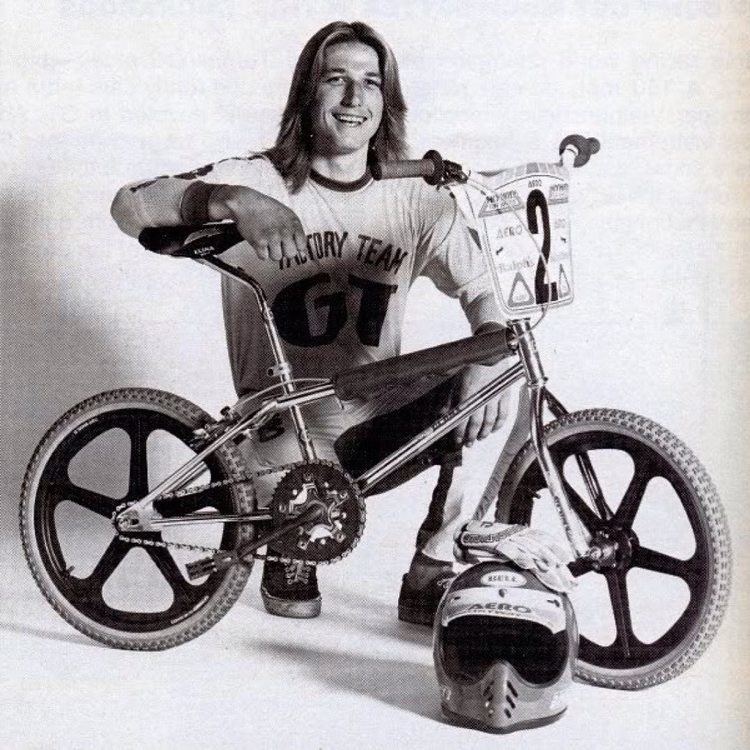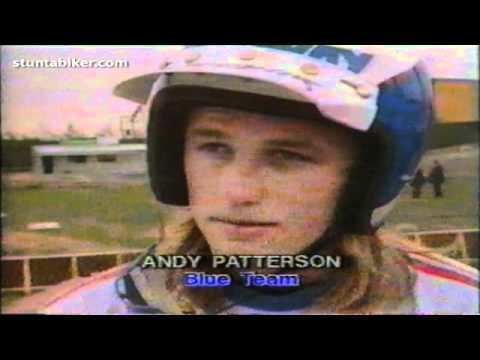Full name Andrew Patterson 1979 TW Racing Weight 84 kg 1978 Addicks Engineering Height 1.90 m | Rider type Off Road Role Bicycler Current team Retired Name Andy Patterson Disciplines BMX racing | |
 | ||
Nickname "Bigfoot", "Mr. Bigfoot" Born | ||
Andy patterson
Andrew Patterson (born January 19, 1964 in Norwalk, California U.S.) was an American professional "Old School" Bicycle Motocross (BMX) racer whose prime competitive years are from 1977 to 1985. His moniker was "Mr. Bigfoot" for his size 13 feet. Patterson was one of the first American racers to compete on the European BMX circuit during its formative years on a regular basis. He developed a large European following.
Contents
- Andy patterson
- Harry Leary Andy PattersonScott ClarkGreg Hillwmv
- Amateur
- Professional
- BMX product lines
- Significant injuries
- Racing habits and traits
- Miscellaneous and trivia
- BMX and general press magazine interviews and articles
- BMX magazine covers
- References
Harry Leary, Andy Patterson,Scott Clark,Greg Hill...wmv
Amateur

Professional
Amateur
National Bicycle Association (NBA)
National Bicycle League (NBL)
American Bicycle Association (ABA)
United Bicycle Racers (UBR)
United States Bicycle Motocross Association (USBA)
Fédération Internationale Amateur de Cyclisme (FIAC)**
International Bicycle Motocross Federation (IBMXF)**
Union Cycliste Internationale (UCI)**
Independent Invitationals and Amateur Series Championships
Professional
National Bicycle Association (NBA)
National Bicycle League (NBL)
United Bicycle Racers (UBR)
American Bicycle Association (ABA)
United States Bicycle Motocross Association (USBA)
International Bicycle Motocross Federation (IBMXF)*
Fédération Internationale Amateur de Cyclisme (FIAC)*
Union Cycliste Internationale (UCI)*
Independent Invitationals and Pro Series Championship
BMX product lines
Significant injuries
Racing habits and traits
One pedal starts involved rearing back with your arms straight out and almost parallel to the ground with one foot behind and to aside the rear wheel. The other foot was on a pedal that was extended forward and the front tire pushing against the starting gate. When the gate dropped a rider would lunge forward placing his weight on the lead pedal, accelerating him out of the gate. If timed right with a quick reaction a racer can get a jump on the others out of the gate called the holeshot. By the early 1980s two pedal starts became the mode in which the vast majority of top racers used. It was almost exactly identical to the one pedal start except the trailing foot was on the trailing pedal as with the leading foot was on the leading pedal. The racer maintained his balance with the friction of the front tire pressed against the gate and the racer subtlety shifting his weight to counteract the imbalance. Getting out of the gate was similar to the one pedal start in that the racer lunged his weight forward against the handle bars while pressing his full weight and leg strength against the lead pedal. Simultaneously you use your upper body strength to quickly pull the bike forward with the handle bars. By the early 1980s most racers felt that this provided a quicker start to the old one pedal start with the advantage of not having to find the rear pedal with trailing foot. Since it is already on the pedal you can concentrate fully on starting and getting out of the gate a second sooner than anyone using a one pedal start technique. Ironically, the sanctioning bodies in the early 80's to cut down on gate jumping by those using the two pedal start who could time the cadence of the gate lights because it fell at a set period of time every time (they use starting lights much like those on a top fuel drag racing drag strip). In 1985 the ABA switched to dead man gates in which the green light didn't light and the gate fall in a predictable fashion making timing the gate difficult (the gate still fell the instant the light turned green of course). Concentrating on when the light turn green was critical with reaction time to that was critical. This made two pedal starts even more of a premium making one pedal starts unheard off by the mid to late '80s.
Miscellaneous and trivia
BMX Plus!: "Did anyone like Haro ever approach you and ask you to tricks [sic] for them?"
Andy Patterson: "Not really. I don't really want to get that much involved in it. I didn't even want to get involved when Pepsi called up and wanted me to do demos for them. It's just in my spare time when I'm not in a race, and I can earn some money by doing it--then I go ahead and do it." ---BMX Plus! September 1982.
BMX and general press magazine interviews and articles
BMX magazine covers
Bicycle Motocross News:
Minicycle/BMX Action & Super BMX:
Bicycle Motocross Action & Go:
BMX Plus!:
Total BMX:
Bicycles and Dirt (ABA Publication):
BMX Weekly & BMX Bi-Weekly (British Publication)
BMX Action Bike (British publication):
Australian BMX Pancake (Australian publication):
NBA World & NBmxA World (The official NBA/NBmxA membership publication):
Bicycles Today & BMX Today (The NBL official membership publication under two names):
ABA Action, American BMXer, BMXer (The ABA official membership publication under three names):
USBA Racer (The official USBA membership publication):
